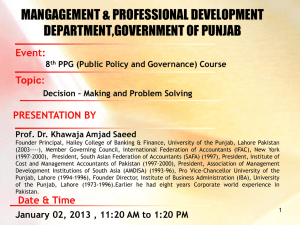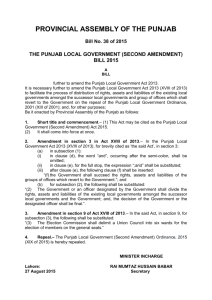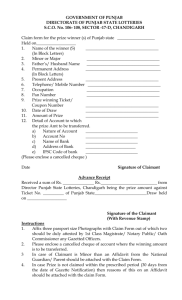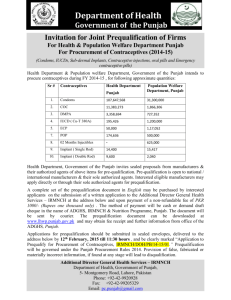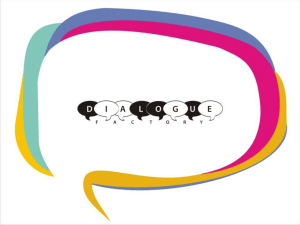MS Word - of Planning Commission
advertisement
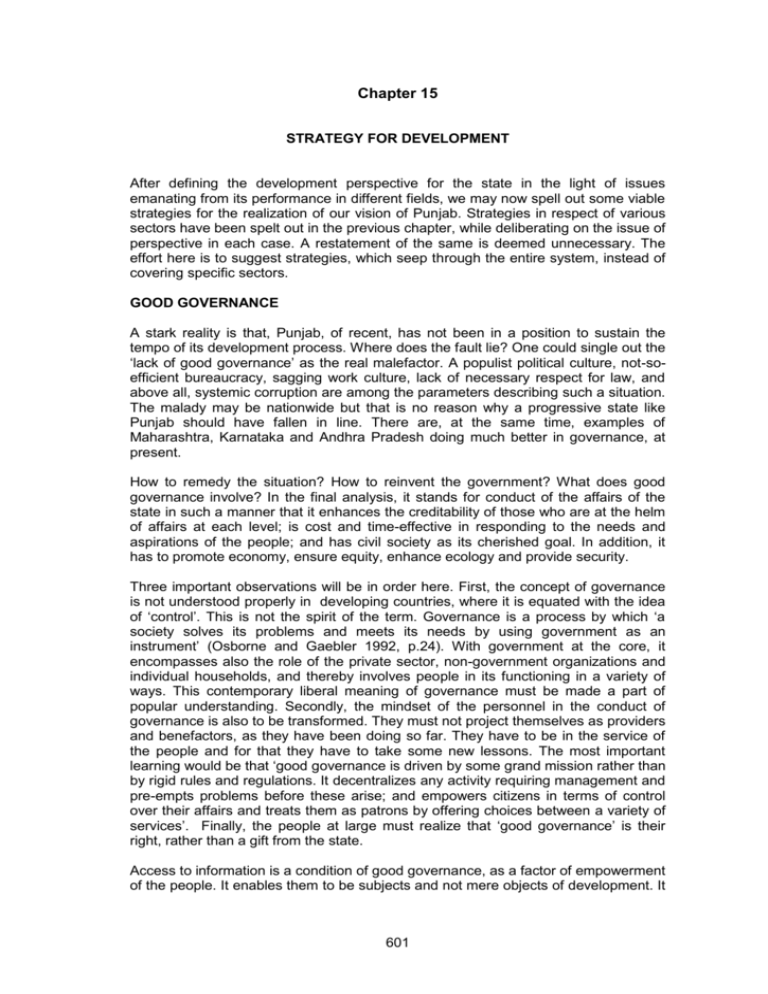
Chapter 15 STRATEGY FOR DEVELOPMENT After defining the development perspective for the state in the light of issues emanating from its performance in different fields, we may now spell out some viable strategies for the realization of our vision of Punjab. Strategies in respect of various sectors have been spelt out in the previous chapter, while deliberating on the issue of perspective in each case. A restatement of the same is deemed unnecessary. The effort here is to suggest strategies, which seep through the entire system, instead of covering specific sectors. GOOD GOVERNANCE A stark reality is that, Punjab, of recent, has not been in a position to sustain the tempo of its development process. Where does the fault lie? One could single out the ‘lack of good governance’ as the real malefactor. A populist political culture, not-soefficient bureaucracy, sagging work culture, lack of necessary respect for law, and above all, systemic corruption are among the parameters describing such a situation. The malady may be nationwide but that is no reason why a progressive state like Punjab should have fallen in line. There are, at the same time, examples of Maharashtra, Karnataka and Andhra Pradesh doing much better in governance, at present. How to remedy the situation? How to reinvent the government? What does good governance involve? In the final analysis, it stands for conduct of the affairs of the state in such a manner that it enhances the creditability of those who are at the helm of affairs at each level; is cost and time-effective in responding to the needs and aspirations of the people; and has civil society as its cherished goal. In addition, it has to promote economy, ensure equity, enhance ecology and provide security. Three important observations will be in order here. First, the concept of governance is not understood properly in developing countries, where it is equated with the idea of ‘control’. This is not the spirit of the term. Governance is a process by which ‘a society solves its problems and meets its needs by using government as an instrument’ (Osborne and Gaebler 1992, p.24). With government at the core, it encompasses also the role of the private sector, non-government organizations and individual households, and thereby involves people in its functioning in a variety of ways. This contemporary liberal meaning of governance must be made a part of popular understanding. Secondly, the mindset of the personnel in the conduct of governance is also to be transformed. They must not project themselves as providers and benefactors, as they have been doing so far. They have to be in the service of the people and for that they have to take some new lessons. The most important learning would be that ‘good governance is driven by some grand mission rather than by rigid rules and regulations. It decentralizes any activity requiring management and pre-empts problems before these arise; and empowers citizens in terms of control over their affairs and treats them as patrons by offering choices between a variety of services’. Finally, the people at large must realize that ‘good governance’ is their right, rather than a gift from the state. Access to information is a condition of good governance, as a factor of empowerment of the people. It enables them to be subjects and not mere objects of development. It 601 is in this context that the IT revolution assumes tremendous significance. It must serve as an instrument of e-governance, among other things. As such, the role of e-governance requires elaboration. This, of course, begins with networking of each of the administrative centres in the hierarchy. Equally essential is to net every panchayat and nagarpalika in the system of e-governance. No less necessary is it to make available details of development schemes, forms for availing opportunities offered by the government, and all other information of public interest, on special websites designed for the purpose. Widespread training of a large number of personnel in computer-use is a prerequisite for promoting such a culture of governance. EMPOWERING LOCAL BODIES How to involve all the stakeholders in the grand task of good governance? The most effective strategy would be to strengthen the local-level elected bodies. This calls for genuine faith in the efficacy of the panchayats (rural) and nagarpalikas (urban), as mandated by the 73th and 74th Constitutional Amendments. Much remains to be done on this count in Punjab. The first necessary step would be to devolve to local bodies all the subjects earmarked for them in the sphere of service provision and development planning and to provide the necessary administrative and technical support for the purpose. Local bodies, in their own turn, should feel obliged to do the following: (i) monitor the quality of services, such as school, dispensary, water supply, electricity and link roads, made available to their locality by the state government; (ii) highlight village problems, such as flooding, water-logging, and plant diseases, so as to draw the attention of those concerned for necessary action; (iii) prepare a blueprint of a development plan of the settlement; and (iv) take care of the natural resource base. All this is easier said than done. It will not translate into a possibility, let alone be a reality, until the members of the panchayats and nagarpalikas are made aware of their obligations and rights, through well-designed training programmes on a continuing basis. The knowledge, technical skill and governance capacity of the peoples’ elected representatives have to be upgraded for ushering in a new era. The task is stupendous, as it has to cover almost one lakh persons of 12,369 gram panchayats, 140 panchayat samitis, and 17 zila parishads in only the rural segment of the state. Thousands of elected members of nagarpalikas are to be taken care of, in addition. The experience of involving of the Centre for Research in Rural and Industrial Development, Chandigarh, in this grand talk demonstrates the effective contribution that non-government organizations can make in this sphere. MICRO-LEVEL PLANNING As a concomitant of political decentralization at the grassroots level, a genuine thrust to micro-level planning, with a village/town or a block or a district as the spatial unit, has to be an essential ingredient of any development strategy for Punjab. What is visualized is an integration of plans prepared for individual settlements, blocks and districts, through involvement of all the stakeholders. This is not the practice at present. Planning and development still remain a government activity, by and large. As a result, the masses have acquired a state-dependency mindset, to the exclusion of local enterprise and leadership. A call for adopting a ‘genuine’ mode of decentralized planning is made here to reverse this tendency, so that a more meaningful socio-economic transformation gets under way through peaceful means. 602 A micro-level plan is in the nature of a blueprint for action. This bears resemblance to building a house whose design is based on a comprehensive understanding of the site-conditions, prevailing architectural style, financial capacity, and future requirements. This analogy should not be carried too far. A micro-region has an already evolved structure, which is to be remodelled. Micro-level planning, thus, comes closer to restructuring an existing house, with a vision. In actual practice, the job may involve the following tasks: recommending location specific projects for filling spatial gaps in the distribution of infrastructure; suggesting ways to harness the potential and solve the problems of the micro-region; reviewing the ongoing schemes and indicating as to which should be made to continue, or be modified, or even abandoned, or which should be adopted as new; promoting schemes in the nature of self-help groups; and identifying special areas of concern, such as backward villages, village common-lands, and hazard-prone sites. Such an exercise requires a detailed mapping of land use, settlement system, and infrastructure. It also demands an insight into the socio-economic life, political contours, institutional arrangements, aspirations and constraints of the people. It presumes a comprehensive and intimate knowledge and appreciation of local conditions. Not much effort is visible on this front. The ground experience is that the Additional Deputy Commissioner, expected to take care of the development agenda, is sometimes not given charge of the relevant subject. Such defaults should be taken care of. Similarly, the office of the block development officer, vital at the local level, is subjected to frequent change of incumbent. A sense of continuity in development planning is simply lacking. It is essential to follow the tenets of development administration, to make micro-level planning effective. Matters are likely to improve if a block is administered by an officer hailing from the Indian Administrative Services, under the proposed scheme of having the district and the block as the only two tiers of administrative areas. ADMINISTRATIVE AREA REFORM A close scrutiny of the administrative map of Punjab, down from the division to the district, tahsil and block level, reveals certain serious distortions in the organization of the administrative space. Currently, the state is organised into four divisions, 17 districts, 72 subdivisions, and 140 development blocks. In 1966, Punjab had two divisions, 11 districts, 37 subdivisions/tahsils and 117 development blocks. Despite some efforts at rationalization, Firozpur district remains unwieldy and Kapurthala fragmented. Boundaries of three districts and seven subdivisions were tampered with to create Fatehgarh Sahib district. It covers an area which is not much bigger than an average subdivision in the state. A periodic administrative area reform, not on an ad hoc but on comprehensive basis, emerges as an essential task for the sake of both administrative efficiency and development administration. There are some other issues to deliberate. Should the state continue with its existing system of divisions, districts, subdivisions or development blocks, or dispense with divisions and subdivisions and retain only districts and development blocks? What is the relevance of a division in a small state like Punjab? Do we need subdivisions when the average number of development blocks in a district is just eight? Multiplicity of tiers in administration generates confusion and creates delays (Krishan and Kant, 1998, p.12). There is still another moot point for deliberation. Should development blocks continue to remain exclusively rural, as they were originally designed, or should any town/s falling within their territorial jurisdiction be also included as part of the block? The rationale of keeping rural and urban areas separate in any scheme of things is 603 difficult to justify in the present context. Such a difficulty arises especially when one is preparing a block plan, potential for rural-urban agro-industrial complexes and integrated development. How is this possible if towns are to be kept out of reckoning ? This is not the way ground realities operate. A block must cover both villages and towns located within its spatial parameters. Such a reform is long overdue. As a development strategy, there is still another way of reforming the administrative areas. Let the boundaries of the state assembly constituencies and those of blocks correspond with each other, and likewise the boundaries of parliamentary constituencies should find conformity with those of higher-level administrative units, such as divisions or a group of districts. An arrangement on these lines will render the imperative congruence between political, administrative and developmental dimensions of the state, at all spatial scales. CIVIL SOCIETY Punjab must strive at evolving itself as a civil society to accomplish all this, and also as an ultimate goal in itself. The basic strands of such a society include: a genuine faith in pluralism as inherent in every system; a reinvented democracy, sensitive equally to aspirations of the minority as much as of the majority; and the presence of all varieties of civil groups, which function not merely in their own interest, but for a collective cause, by influencing the decision makers. Civil society does not allow the government to be authoritarian, but has no design on its part to be a ‘political equivalent of the private sector’. Its aim is to transform differences into complementarities, competition into co-operation, and distance into proximity. Thereby, it ensures identity, dignity and liberty to every individual (Uberoi, 1999, p.104). A ‘humane future is envisioned’, with the state as a more ‘responsive than repressive’ agent. Cultivation of appropriate ‘cultural values and civic virtues’ is basic to the attainment of such a goal. Punjab, as a society, is marked by a significant degree of structural stratification and spatial segmentation. Structurally, it displays diversity in terms of religion (Sikh, Hindu, Christian, Muslim and others); caste (higher, peasant, artisan, service, and Scheduled ones); and status (landowning or landless and native or inmigrants). The urban and rural back-ground, and also the sub-regional identity of the Majha, Doaba and Malwa, on traditional lines, represent the spatial parameters of distinction. This is the context in which the question of civil society in Punjab is to be placed. Punjab is the only Sikh-majority state of India. With 63 per cent of its population Sikh and 34 per cent Hindu in 1991, the state is essentially bi-religious. A happy feature is that the two communities have a common heritage, shared values, and similar lifepractices. A tradition of honouring each other’s religion has always existed. As a fact of history, the Hindus in Punjab were more urban-based, and the Sikhs concentrated predominantly in rural areas; the former more in trade and services and the latter in agriculture. Over time, a kind of complementarity and interdependence between the two took shape on economic lines. With the spread of education and the recent acceleration in the process of urbanization, accompanied by migration from villages to towns, the proportion of Sikhs in urban areas has been enlarging. They have been entering into services, trade, transport, industry and other urban vocations in an increasing number, particularly after the formation of Punjab in 1966. This has brought the two communities on a more interactive common space and mutual interdependence, a situation which can facilitate the formation of a civil society. 604 Both the Sikh and the Hindu communities have their caste divisions. The primary one is that between the Scheduled Castes and the non-Scheduled ones. It is estimated that among the Scheduled Castes, who now account for around one-third of the state’s population, more than one-half are Hindu and nearly one-half Sikh. They have to contend with common issues of economic upliftment and social mobility. The factor of religion gets diluted in their case. The task of working towards a civil society in the state gets simplified, by bringing the two religious groups onto a common space. A notable feature of the evolving scene of Punjab’s demography is the sizeable inflow of migrants, from the Hindi belt, mainly as agricultural and industrial labourers. They are integrated economically with the native society, but to what extent are they socially linked is a moot question. Some chauvinists view this trend as disturbing as it will affect the electoral calculations of those with vested interest. Mercifully, such a feeling is not pervasive; certainly not expected on the part of a community which itself has sought new pastures, not only within the country but also in foreign lands. The intention here is to indicate that we should try to cultivate desired perceptions on this front, in the interest of the civil society that we envision. Finally, what should be the strategy for the realization of a civil society in Punjab? This objective will be best achieved if non-governmental organizations are encouraged to play a big role, especially in rural areas, by way of organizing people to solve their problems. Such groups tend to be plural in composition and are expected to imbibe values, which are civic in nature. Non-governmental organizations, on their part, have to learn a great deal from the style of missionary institutions. They have to work with all dedication. In other words, while working towards the goal of designing a civil society, they must combine education, health, and human values as part of their activities. Secondly, in recognition of the fact that the Punjab society is highly materialistic and pragmatic, it will be necessary to demonstrate that a civil society is in the economic interest of each of its members. They must feel convinced that such a system is indispensable for protecting and sustaining their relative prosperity. A cost-benefit analysis of conflict resolution on these lines will change their perceptions for the better. Finally, it is not merely education but its quality built through the input of dedicated teachers as a role model, which can facilitate this process. They are the ones who produce the decision makers, administrators, doctors, engineers, and teachers themselves, among others, and influence the overall value system of a society. Civil society must have the ‘teacher’ at the centre of its all-strategic formulations. GENDER SENSITIVITY An issue most critical to the creation of a civil society in Punjab is to render due status to women in the overall scheme of things. Despite its impressive gains in economic development, exposure to the developed world, and spread of education, the society here is not as just to the fair sex as expected. By and large, a girl child remains unwelcome at birth and women face neglect and discrimination in various forms at different stages of their life. In the first post-independence Census of 1951, Punjab’s sex ratio, which is an indicator of the very survival rate of the female, was only 854; even after fifty years it improved to only 874 in the 2001 Census. These figures are much below the sex-ratio at birth of around 950 and are a pointer to the higher mortality rate of females. Punjab’s total fertility rate, representing the number of children a woman is likely to bear in her life-time, was higher than the national average till 1971. In 1998-99, Punjab’s female infant mortality rate, at 65, was distinctly above the male infant mortality rate of 50. 605 Most worrisome is the recent rising incidence of female foeticide, estimated at around 90,000 a year, in response to the easy accessibility of the pre-birth sound scanning technique. This is manifest in a sharp decline in the sex ratio of 0-6 age group from 875 to 793 during the last intercensal decade of 1991-2001. Urban and rural areas do not differ much in this regard, signifying that the practice of female foeticide is fairly widespread. This uncivil propensity, which is an evil device to marry family planning with son-craze, is unpardonable and poses a challenge to be met with effectively. On the other hand, the emerging situation is not without some positive pointers. The 73rd and 74th Constitutional Amendments have mandated reservation of at least one-third of the seats in panchayats and nagarpalikas for women. This has certainly changed conditions in their favour, as far as political representation at the local level is concerned. The share of women among government employees in the state has gone up from 14 per cent in 1981 to 17 percent in 2001. Most notably, girls outnumber and outshine boys on the college and university campuses in the state. Much remains to be done. A basic task is to instill the value of the daughter in the son-crazy psyche of Punjab. One necessary step would be to make liberal education universal, wherein gender sensitivity is convincingly ingrained as a part of learning. On pragmatic lines, the issue of the status of women can be addressed through two strategies: (i) small family, wherein they are not to bear large number of children restricting their mobility, and (ii) economic self-reliance, which gives them a greater leverage in taking life-decisions. As such, promotion of family planning and generation of women-friendly job opportunities emerge as the two basic steps towards the realization of this goal. SUSTAINABLE SOCIETY Finally, any development strategy for Punjab has to incorporate the elements of environmental, politico-economic and socio-cultural sustainabilities. Environmental sustainability is assured if the inherent productivity of the ecosystem is not made to suffer any loss; rather it is enriched in terms of its constituents, individually and collectively. This is possible if the life-support system is protected from contamination of water, degradation of land, depletion of soil fertility, removal of vegetation cover, pollution of air, and loss of biodiversity. From the viewpoint of politico-economic sustainability, all such modes of production and political institutions are to be promoted, which lead to a higher level of economic well-being and allow people to participate in decision making relevant to their day-to-day life, mutual interaction, and integration with the wider global context. Socio-cultural sustainability is a function of the freedom which people enjoy in pursuit of happiness, harmony and justice, as also of fulfillment of the life-values they cherish. Punjab is not in a comfortable situation on the question of multifaceted sustainability. Economic development has extracted a heavy ecological price; functioning of the politico-economic system is riddled with infirmities; and socio-cultural institutions are under the stress of moral collapse. The question of sustainability is rarely raised beyond its economic parameters. Ethical questions are described as lacking pragmatism. Traditional culture is losing its sheen. What to do and where to go? How to transform Punjab into a prosperous, good-governed and civil society state on a sustainable basis? That is the question. 606 CONCLUDING REMARKS The discussion in this and the preceding chapter allows us to put together the main strands of the development strategy for Punjab. These include: rejuvenation of the socio-economic dynamism of the state; improvement in the quality of life as well of habitat in both rural and urban areas; upgradation of the human resource base by improving the quality of educational and health services; diversification of the economy from agriculture to non-agriculture, of agriculture toward non-farm activities, and of wheat-rice rotation towards ecologically viable crop-combinations; and effective management of water and soil. Additional issues pertinent to the development perspective can be listed as: How to make Punjab investment friendly for industry? How the state should be meeting the challenges posed by globalization of the economy, labour-replacing new technologies, and overproductive biotechnology? How to promote a culture of taking rational locational decisions, wherein economics leads politics rather than politics leading economics? An item not to be missed on any agenda of a development perspective for Punjab relates to raising the ‘status of women’ in society. In the final analysis, ‘rejuvenation, quality, and management’ emerge as the three key ingredients of reinventing Punjab today. For years after independence, Punjab effectively demonstrated that it could lead in the mode of a model state in India. Today, it is craving to be led for full the realization of its potential in the making of a prosperous, just and civil society. The tide will turn only when leaders with foresight awaken the state from the slumber of past glory and create a space for new dreams to manifest. Reference Krishan, Gopal and Surya Kant (1998), “Administrative Space” in J.S. Grewal and Indu Banga, Punjab in Prosperity and Violence: 1947-1997, K.K. Publishers, New Delhi. Osborne, David and Ted Gaebler (1992), Reinventing Government, Prentice Hall of India, New Delhi. Uberoi, J.P.S. (1999), Religion, Civil Society and the State, Oxford University Press, Calcutta. 607
